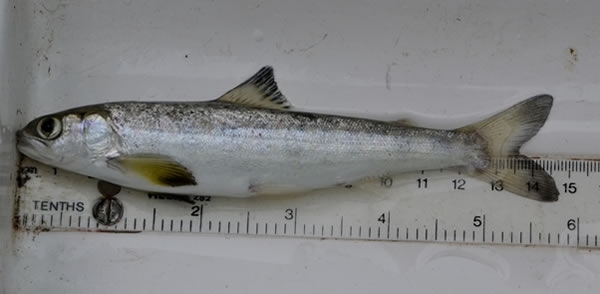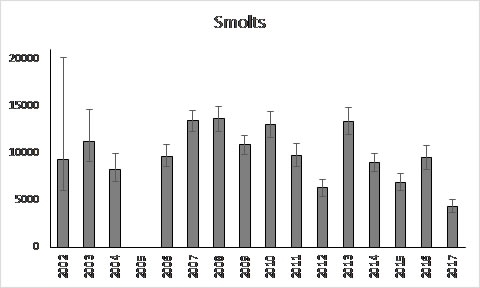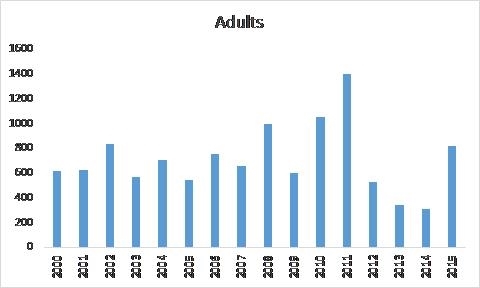
The low number of juvenile salmon (called smolts) leaving the River Frome in Dorset for their feeding grounds in the North Atlantic in the spring of 2017 (called the smolt run) quantified by the Game and Wildlife Conservation Trust in collaboration with Cefas and the Environment Agency is likely to result in a decline in the numbers of adult salmon returning to our rivers in the next few years. This work forms part of a project called SAMARCH part funded by the EU’s Interreg Channel Programme.
In fact, the estimated numbers of smolts leaving the River Frome in spring 2017, 4,381 ±670 was the worst on record and less than half of 10-year average (9,689) and 2,000 fewer than the second worst year on record (2012; see Figure 1).
Dr Rasmus Lauridsen, Head of Fisheries Research for the Trust, said: “The number of young salmon leaving our rivers has a direct effect on the number of adults returning to spawn and, with adult numbers already at an all-time low, this is worrying data for an iconic and economically important species.”

Figure 1: Estimate of number of salmon smolts
emigrating from the River Frome with 95% confidence intervals
Juvenile salmon (also known as “parr”) grow fast in southern English chalk streams and >95% smoltify and leave the River Frome at one year old. On rivers, in the rest of the UK, most salmon smolt leave for the sea at 2-3 years old. The poor 2017 smolt run on River Frome was, therefore, a result of recruitment from the adult fish that spawned in the winter of 2015/16.
Low numbers of young salmon were already apparent during our annual parr tagging campaign in late summer of 2016, for which the catchment population was estimated to be 35,151, which is substantially fewer than the 10-year average (91,353).
Poor recruitment of salmon from the 2015/16 spawning season has been observed in many rivers across England and Wales. See, for example, this press release from Natural Resources Wales. This suggests that it was a national, rather than a local, phenomenon.
In 2015, we recorded 822 adults entering the River Frome for the 2015/16 spawning season, which was slightly more than the 10-year average 746 (see Figure 2). This suggests that the problem affecting recruitment must have occurred sometime between spawning in the winter of 2015/2016 and the late summer of 2016 rather than fewer than normal spawning fish.

Figure 2 Number of adult salmon recorded returning to the River Frome
Why are the numbers so low?
We noted that the weather was particularly warm during the early part of the winter of 2015/16, i.e., when the adult salmon were laying their eggs in the river. The high air temperature was reflected in high River Frome water temperatures: the average water temperature for December 2015 was 11.2°C, which is the warmest December temperature recorded this millennium, 3.3°C warmer than the average December temperature and 2.0°C warmer than the second warmest in this millennium.
We speculate that the high water temperature during spawning and early egg incubation had a negative impact on egg survival and subsequent parr recruitment as this has previously been observed in temperature controlled experiments.
Although we cannot exclude other factors, we believe the floods affecting parts of the UK during the winter of 2015/16 are unlikely to have caused “egg washout” in a low energy system, such as the River Frome.
River Frome acting as an early warning system
As a result of the small 2017 smolt run, we are expecting fewer adults to return to River Frome in 2018 and 2019, i.e., salmon that spent 1 and 2 years at sea, respectively. Furthermore, we would expect fewer than average adult returns in other affected rivers throughout the UK, albeit that the effects might be seen in later years depending on the age that their smolts go to sea.
Thanks to the unique data collected by the GWCT, Cefas and the Environment Agency, we can view the River Frome as an early warning system that affords us an opportunity to take action before the horse has bolted.
In contrast to the 2017 smolt run, the lowest number of spawners recorded entering the River Frome since 1973 were observed in 2013 and 2014. Yet, these low numbers of spawners resulted in larger numbers of smolt than estimated in 2017 (see Figure 1).
In recent years, there has been considerable focus on understanding factors affecting the marine survival of salmon, which is the focus of the SAMARCH project 2, and while their marine survival appears to be low, the poor recruitment from the 2015/16 spawning season is a stark reminder that we must not forget the importance of the freshwater stage the salmon lifecycle and it’s potential to affect stocks in subsequent years.
Please support our Salmon Appeal
We're currently working on finding out why Atlantic salmon numbers have dropped by as much as 70% in some areas. Please give what you can afford so that our scientists can continue their vital work.